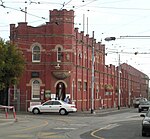House at Caulfield

House at Caulfield, is a family home situated at 450 Dandenong Road in Caulfield North, Melbourne, Victoria, Australia, designed by Anatol Kagan in 1956 for Polish-Jewish emigre Leo Lind and his wife Dorothy. Born in Russian on October 4, 1913 Anatol Kagan's career as an architect spanned over seven decades until his death on July 2, 2009. He was actively involved in the field of design, as well as a writer, translator, lecturer and political activist. The house is an important work of its period demonstrating the Modernist architectural movement of Melbourne during the mid 20th Century, and in 2018 was added to the Victorian Heritage Register. Kagan was also influenced by the works of his local contemporaries, Roy Grounds, Frederick Romberg and Robin Boyd.
Excerpt from the Wikipedia article House at Caulfield (License: CC BY-SA 3.0, Authors, Images).House at Caulfield
Dandenong Road, Melbourne Caulfield North
Geographical coordinates (GPS) Address Nearby Places Show on map
Geographical coordinates (GPS)
| Latitude | Longitude |
|---|---|
| N -37.862944444444 ° | E 145.01875 ° |
Address
Stop 42: Kooyong Road
Dandenong Road
3143 Melbourne, Caulfield North
Victoria, Australia
Open on Google Maps









